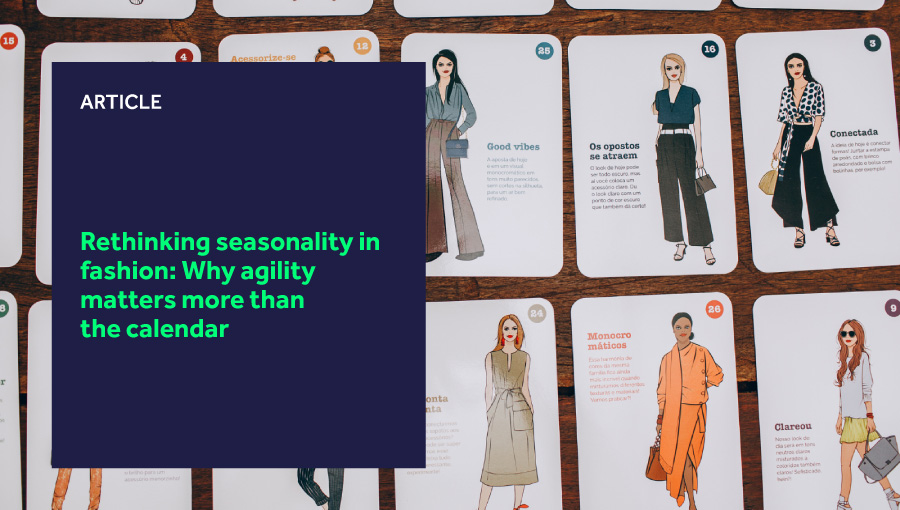Fashion’s calendar always ran like clockwork. Spring/Summer and Autumn/Winter drops defined everything from product development and merchandising to marketing and logistics.
This playbook, while still followed by many, is antiquated. Between fast fashion’s race to the bottom and consumer expectations for newness, seasonality as a concept is too rigid.
Brands, already operating on compressed timelines, must now find the operational agility to plan collections more flexibly and break free from the old ways.
The decline of seasonality isn’t inherently negative
The reasons behind a person’s decision to purchase have fundamentally changed. While some still shop for summer or winter clothes, the reality is that people’s needs are constantly in flux.
Some may venture to sunny destinations in the winter, or ski in off-peak times. Naturally, this shifts demand for once traditionally seasonal pieces. People look for what they need, when they need it, and expect to find it available in the right size from a brand they trust.
This does present complications for brands built around long lead times and carefully timed launches. At the same time, however, it also opens the door for new opportunities.
Chiefly, those who embed more responsive, data-driven and customer-focused models will be in prime position to align their offerings with how people actually shop today and ultimately profit.
Adapting now ensures longevity in a difficult market
It may seem painful to move away from tried-and-true models, but persisting with obsolete processes will only spell disaster in the long run.
A survey by BoF Insights found that only 12% of shoppers in the EU5 (UK, Germany, France, Italy and Spain) report trendiness as a top priority when shopping online for fashion.
Instead, shoppers prioritise quality, confidence in size and fit and delivery reliability. The survey is a crucial reminder that purchase drivers aren’t always about newness, but rather trust, convenience and consistency.
This plays directly into the strengths of a seasonless approach. By moving away from rigid seasonal drops and focusing on always-available, best-performing items, brands gain flexibility.
Styles can be tweaked and restocked based on real-time performance, rather than projections made six months prior. At the same time, customers will be more likely to find what they’re looking for and brands will be less likely to be burdened by excess stock and discounts.
Discovery is reshaping demand
The product itself isn’t the only factor that underscores this shift; the way customers find, experience, and consume fashion online is equally key.
Discovery doesn’t solely begin in-store or on a brand’s homepage anymore. It often starts on a multi-brand platform like Asos or Amazon. The same BoF Insights survey reveals that 39% of EU5 shoppers turn to multi-brand platform retailers first when looking for inspiration.
Such discovery hubs are vital tools that help people navigate choices and find styles that match their wants. These platforms will only grow in relevance as AI is deployed to combat the issue of choice paralysis, which many consumers find limiting when shopping online.
For brands, the takeaway is clear. Multi-channel presence is a necessity to build brand equity and trust. While physical stores and websites remain crucial touchpoints, diversifying and collaborating with online multi-brand retailers is key to tapping into a wider audience.
Visibility is no longer just a marketing tool to drive awareness. It’s a lever to reinforce credibility and ensure that when people want to make a purchase, your brand is top of mind.
Fit, fulfilment and the new rules of customer trust
Sizing has long been one of fashion’s greatest banes. While people may be one size from one brand, they could be a completely different size from a separate brand. Inconsistent sizing across brands continues to frustrate shoppers and undermine loyalty.
Over 40% of EU5 customers tell BoF Insights that personalised size recommendations are a top influencing factor when shopping online. This is another area where AI will help improve CX. Amazon Fashion’s AI-powered fit recommendation tool, for instance, has reportedly satisfied more than 90% of customers who followed the suggestions.
In a seasonless model, nailing sizing becomes non-negotiable. It reduces returns, boosts trust and protects margins, all critical factors for long-term profitability.
In the same vein, fulfilment is another area that must be addressed to truly move to a seasonless model. Customers already have high expectations for speed and service.
As we’ve discussed before, this is where never-out-of-stock staples shine. By continually stocking popular pieces that are always available, brands can meet consumer demand for rapid fulfilment and quality.
To take that a step further, however, truly seasonless models require sophisticated systems that consolidate data from all sources to inform replenishment and stock adjustments based on actual data, rather than static plans. This allows supply chains to flex with demand.
Creativity still sits at the heart of fashion’s cycle
None of this should be used to suggest that creativity is irrelevant in fashion. Design still matters. Product still matters. The only difference is that it must all happen in real time.
Success is contingent on meeting customer needs in the here and now, not next season.
Strong products backed by consistent availability, trusted shopping experiences, and confidence in fits will build loyalty and long-term value.
While consumer behaviour fluctuates with economic uncertainty, brands must stop thinking in the ways of old and understand that people no longer think in seasonal ranges or collection names.
They think about what is valuable to them.
Brands that align inventory strategies with this new paradigm will undoubtedly be poised for long-term success. Flexible and responsive models are the new norm.
Found this useful and want to know how you can make data-backed decisions in your brand?
Contact us now to find out how our fashion ERPs can enhance your inventory strategy and better align with customer demand.
 https://k3fashionsolutions.com/wp-content/uploads/2025/11/exception-economy-featured.jpg
510
900
Jordan Heal
https://k3fashionsolutions.com/wp-content/uploads/2024/12/K3_Fashion_Solutions_Half-color_RGB.svg
Jordan Heal2025-11-25 09:41:202025-11-25 09:41:20The exception economy: Why order allocation in fashion keeps breaking
https://k3fashionsolutions.com/wp-content/uploads/2025/11/exception-economy-featured.jpg
510
900
Jordan Heal
https://k3fashionsolutions.com/wp-content/uploads/2024/12/K3_Fashion_Solutions_Half-color_RGB.svg
Jordan Heal2025-11-25 09:41:202025-11-25 09:41:20The exception economy: Why order allocation in fashion keeps breaking


